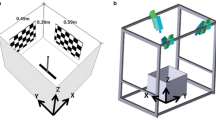Summary
-
1.
All experiments were performed on freely flyingDrosophila in a new, horizontal wind tunnel where the visual input was provided by the apparent axial movement of rotating helical patterns surrounding the cylindrical working section. The flies were flown upwind along a narrow plume of attractant odour in the mid-line of the tunnel so their visual input was specified.
-
2.
When the pattern was at a constant distance from the flies they controlled their groundspeed by flying at an airspeed such that there was a constant angular velocity of image movement rather than a constant frequency of stripe alternation over their eyes. They thus flew at the same groundspeed regardless of wind speed.
-
3.
When the distance of the pattern from the flies changed in a step, the flies adjusted their airspeed at the change so as to keep a relatively constant groundspeed. They did this by changing the angular velocity of image movement that they held constant.
-
4.
When the distance of the pattern from the flies changed gradually, on a cone rather than in a step, the flies did not adjust the angular velocity of image movement that they held constant. Their groundspeed thus did not remain constant.
-
5.
It is suggested that the flies used parallax cues, from the different apparent angular velocities visible juxtaposed on either side of a step in pattern distance, to adjust the angular velocity of image movement that they held constant.
Similar content being viewed by others
References
Cardé RT, Hagaman TE (1979) Behavioural responses of the gypsy moth in a wind tunnel to air-borne enantiomers of disparlure. Environ Entomol 8:475–484
Cartwright BA, Collett TS (1979) How honeybees know their distance from a near-by visual landmark. J Exp Biol 82:367–372
Collett TS (1978) Peering — A locust behaviour pattern for obtaining motion parallax information. J Exp Biol 76:237–241
David CT (1978) The relationship between body angle and flight speed in free-flyingDrosophila. Physiol Entomol 3:191–195
David CT (1979a) Height control by free-flyingDrosophila. Physiol Entomol 4:209–216
David CT (1979b) Optomotor control of speed and height by free-flyingDrosophila. J Exp Biol 82:389–392
Daykin PN (1967) Orientation ofAedes aegypti in vertical air currents. Can Entomol 99:303–308
Eriksson ES (1980) Movement parallax and distance perception in the grasshopper (Phaulacridium vittatum (Sjastedt)). J Exp Biol 86:337–340
Götz KG (1964) Optomotorische Untersuchung des visuellen Systems einiger Augenmutanten der FruchtfliegeDrosophila. Kybernetik 2:77–92
Götz KG (1970) Fractionation ofDrosophila populations according to optomotor traits. J Exp Biol 52:419–436
Heran H (1956) Ein Beitrag zur Frage nach der Wahrnehmungsgrundlage der Entfernungsweisung der Bienen. Z Vergl Physiol 42:168–218
Heran H, Lindauer M (1963) Windkompensation und Seitenwindkorrektur der Bienen beim Flug über Wasser. Z Vergl Physiol 47:39–55
Kennedy JS (1940) The visual responses of flying mosquitoes. Proc Zool Soc Lond [A] 109:221–242
Kennedy JS (1951) The migration of the desert locust (Schistocerca gregaria Forsk.). Philos Trans R Soc Lond [Biol] 235:163–290
Kennedy JS, Marsh D (1974) Pheromone-regulated anemotaxis in flying moths. Science 184:999–1001
Kennedy JS, Thomas AAG (1974) Behaviour of some low-flying aphids in wind. Ann Appl Biol 76:143–159
Kennedy JS, Ludlow AR, Sanders CG (1981) Guidance system used in moth sex attraction. Nature 288:475–477
Marsh D, Kennedy JS, Ludlow AR (1978) An analysis of anemotactic zig-zagging flight in male moths stimulated by pheromone. Physiol Entomol 3:221–240
Moericke V, Prokopy RJ, Berkocher S, Bush GL (1975) Visual stimuli eliciting attraction ofRhagoletis pomonella (Diptera: Tephritidae) flies to trees. Entomol Exp Appl 18:497–507
Siegel S (1956) Nonparametric statistics for the behavioural sciences. McGraw-Hill, New York
Wallace GK (1959) Visual scanning in the desert locustSchistocerca gregaria Forskal. J Exp Biol 36:512–525
Wehner R, Horn E (1975) The effect of object distance on pattern preferences in the walking fly,Drosophila melanogaster. Experientia 31:641–643
Author information
Authors and Affiliations
Rights and permissions
About this article
Cite this article
David, C.T. Compensation for height in the control of groundspeed byDrosophila in a new, ‘barber's pole’ wind tunnel. J. Comp. Physiol. 147, 485–493 (1982). https://doi.org/10.1007/BF00612014
Accepted:
Issue Date:
DOI: https://doi.org/10.1007/BF00612014




